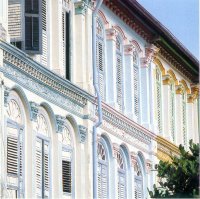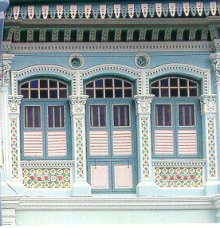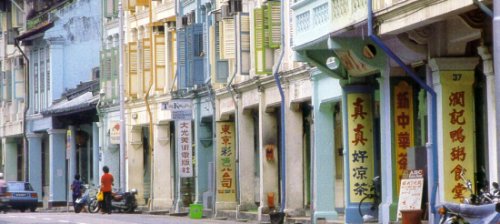 As one saunters through the streets of Chinatown on a sunny day, one will be amazed at how harmoniously blended though in greater contrast an old pre-war shophouse is standing side by side to a renovated one. These sights of the old and renewed intermittently appearing in random as one goes down the streets only serves to remind us of the nostalgic past and our present efforts to preserve it.
As one saunters through the streets of Chinatown on a sunny day, one will be amazed at how harmoniously blended though in greater contrast an old pre-war shophouse is standing side by side to a renovated one. These sights of the old and renewed intermittently appearing in random as one goes down the streets only serves to remind us of the nostalgic past and our present efforts to preserve it.
 Back in the 19th century, the concept of a Chinese Town was first conceived by Sir Stamford Raffles. Dissatisfied with the haphazard way the settlement around Singapore River and Boat Quay had developed with the sudden influx of immigrants mainly from China, Stamford Raffles issued a plan proposing a Chinese Kampong to the Town Planning Committee in 1822.
Back in the 19th century, the concept of a Chinese Town was first conceived by Sir Stamford Raffles. Dissatisfied with the haphazard way the settlement around Singapore River and Boat Quay had developed with the sudden influx of immigrants mainly from China, Stamford Raffles issued a plan proposing a Chinese Kampong to the Town Planning Committee in 1822.

Our professional team provides knowledgeable & customized services to prospects seeking overseas academic advancements, migration, transfers, application of visas, arrangement of accommodation & relocation, pre departure arrangement etc. Seeking consultation, please call : China Customer Service Hotline: 400-7160816 or Singapore Service Hotline:+65 6737-9958
We have established long term strategic partnerships with various well-known portals, one of which will be Agoda, please click: :"http://www.agoda.com.cn/asia/Singapore/Singapore.html?Cid=14459
Below are our affiliates' homepage:
Overseas Educational Services 新加坡留学网www.eistudy.com
Rental of Residential Properties 新加坡公寓网http://www.65house.com
Immigration 新加坡移民网http://www.65pr.com
Singapore Property Investment 新加坡房产网http://house.heysg.com
(Chief Editor:xiaoya)About US|Joined Coopertion|Media Reports|Careers|Useful Links|Advertise|Copyright|Legal Consultant|Contact Us
Copyright ©2009-2012 65hostel.com